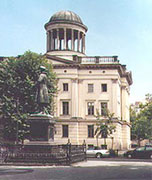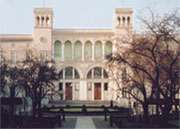Museums and Galleries in Berlin
Until 1989 Berlin was divided by the Wall into two separate cities,
each with its own art and antiquities collections. Only now, more
than ten years after German re-unification, are the Art and Museum
collections of the two halves of the city being merged, and this,
combined with renovation work on a couple of the older buildings,
leads to some uncertainty as to what is be found where. But let
yourself be surprised.
On Friedrichstraße, in the east of the city, Checkpoint Charlie
Museum, adjacent to the notorious Cold War border crossing between
the Russian and American sectors, details the amazing escape attempts
across the Berlin Wall and former West and East German border
- by tunnel, balloon and home-made submarine.
 Museum
Island features five buildings, most notably the newly-opened
Old National Gallery, the Old Museum and Pergamon Museum. Here
you can see the grand imperial collection of antiqities from the
Middle East, including the Ishtar Gate and the Pergamon altar,
one of the city's Egyptian collections, with the famous bust of
Nefertiti, and the Schliemann collection, named after the archaeologist
who discovered Troy. Museum
Island features five buildings, most notably the newly-opened
Old National Gallery, the Old Museum and Pergamon Museum. Here
you can see the grand imperial collection of antiqities from the
Middle East, including the Ishtar Gate and the Pergamon altar,
one of the city's Egyptian collections, with the famous bust of
Nefertiti, and the Schliemann collection, named after the archaeologist
who discovered Troy.
Take in a bit of the city's history at a number of museums and
exhibitions. The Märkisches Museum is home to standing exhibit
marking Berlin's historical and cultural development from the
Middle Ages to the present.
The Story of Berlin is a one-of-a-kind exhibition. A genuine
feast for the senses. Experience the history of a metropolis like
never before. From the early days to the Golden Twenties, the
burning of books and the terror of the Third Reich, to the fall
of the Berlin Wall. With this multimedia production you can actually
see, hear, smell and touch the city's past.
In the south-west of the city, Dahlem's Anthropological Museum
contains reconstructions of boats and huts on stilts from Oceania.
Next door are artifacts from India, China, Korea and Japan.
For the more eclectic the city offers a Sugar Museum, a Museum
of the Postal Service and Communication, and an imaginative Museum
of Transport and Technology with trams and Underground carriages
from the early part of the century.
The New National Gallery on Potsdamer Platz, designed by Mies
van der Rohe, is the site of regular major Art exhibitions - recently
Max Ernst. Its older counterpart, the Old National Gallery which
stands behind the Lustgarten and Berliner Dom, has mostly German
work (Expressionist and Impressionist) including Monnet, Nolde,
Barlach and Kollwitz. The Brücke Museum in Dahlem has a permanent
exhibition of the work of the group that included Kokoschka.
 The
old Hamburger Station, now converted into a modern art gallery,
regularly puts on modern works as well as a large permanent exhibition
of the Erich Marx and, soon, the Flick collections. The
old Hamburger Station, now converted into a modern art gallery,
regularly puts on modern works as well as a large permanent exhibition
of the Erich Marx and, soon, the Flick collections.
The old royal palaces
also have important collections - Dürer, Cranach - and there are
countless smaller private galleries, throughout Schöneberg, Charlottenburg,
Mitte and Kreuzberg displaying young artists from all over Germany.
Additionally there are regular startlingly innovative exhibitions
- recent examples are "Holography" at the Kulturbrauerei in Prenzlauerberg,
and "Seven Hills", an exploration of the future comprising seven
installations/environments, at Martin Gropius Bau.
And throughout the city, round Savigny Platz in Charlottenburg
in the west, and Oranienburger Strasse in the east, small independent
galleries give you a glimpse of modern Art at its wildest and
whackiest. See, in particular, Tacheles, a vast semi-ruined pre-war
department store, now converted into a cultural center.
See
list of Berlin museums here
© 2002-2003 Berlin Travel Service - A1 Design All rights reserved.
|